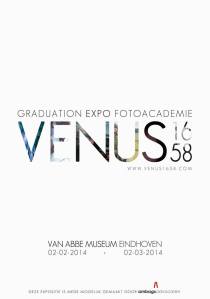Yesterday I attended the opening of an exposition in a museum in Eindhoven, the Netherlands: people, speeches, and ‘art’. As speeches can be the most difficult things to endure, especially when they seem to promote or discuss something irrelevant, here is my alternative opening speech.
Dear friends, family, photographers, teachers, and everyone else,
Welcome to Venus 1658, presenting six young graduated photographers in the Van Abbemuseum. A museum that is dear to me for various reasons – perhaps due to their semi-permanent collection of Lissitzky, the intriguing architecture of the building that keeps surprising me after all these years, or the manner in which they continue to place themselves into the heart of public life. And now, they are hosting the work of six newly graduated photographers who finished an intensive program at the Fotoacademie.
Presenting one’s work in a museum takes courage. All of a sudden one’s work is exposed to the public. The safety of the academy, one’s peers and the protection of calling oneself a student is left behind. There is only this: grey walls and strangers walking along, instantly judging what they see, what they experience. Perhaps they will laugh, perhaps they will feel moved. Perhaps they won’t even see your work, temporarily distracted by something else, a phone call. But, perhaps, they will spend an hour or more perusing every inch, every second of what can be seen here. Who knows?
Exposing one’s work takes extra courage when the work is the outcome of years of study. To explain that, allow me to say a few words on the difference between studium and punctum as was developed by Roland Barthes, a French philosopher, who saw the rise of photography and was concerned of what it would do to our understanding of art. Nowadays photographers are faced with the huge amount of people taking photographs continuously and sharing them instantly – how can they distinguish themselves from merely taking a shot? Barthes was concerned about another issue, an issue which is still relevant, even more relevant today for photographers. How and when is the photograph more than a technical reproduction of reality? Can a photograph be considered art?
It is not my place to judge the work that is exposed here in the Van Abbemuseum as to whether it can be considered art or not. It is everyone’s duty to consider this for herself. Yet I can share Barthes’ insights, which might give a language to an intuition that every human being has when confronted with a piece of art. And this concerns the difference between ‘studium’ and ‘punctum’, two aspects of experiencing a photograph.
Studium doesn’t refer just to ‘study’, it refers to a kind of fascination that is based on habit, on customs regarding what is deemed beautiful. It is a kind of beauty that can be calculated, thought about. And many photographs have this quality of studium. The subjects are posed in a certain manner which is aesthetically valuable and confers a harmony. Although Barthes does acknowledge this kind of photograph is valuable, I would call this type ‘boring’. It does not catch one’s attention longer than a few seconds. As Barthes says: “Many photographs are, alas, inert under my gaze. But even among those which have some existence in my eyes, most provoke only a general and, so to speak, polite interest: they have no punctum in them: they please or displease me without pricking me: they are invested with no more than studium.” (Camera Lucida, 27)
Punctum on the other hand is what cannot be premeditated. It is an arrow that strikes, that pricks you without any specific reason. The artwork – be it photographs, sculptures, moving images, paintings – it ‘speaks’ of something beyond the subject being depicted. Punctum involves a certain disturbance of tradition, of what is expected. This is what makes art art. Which makes that the true artist can never use the same style, the same approach twice, as she is always searching for a breaking away from what has already been done.
Punctum cannot be forced. It is a surprise for the artist. Art is not like baking a cake, adding all the right ingredients and adding some punctum in the end, for flavour.
This exposition presented to you comprises of a varied mix of works of art. I am very happy that we will all have the opportunity to investigate what is exposed here, to approach each work in its unique nature, and decide for ourselves where we can find studium and perhaps, if we are lucky, and if we allow ourselves to be touched, we will be able to experience the punctum of some other works.

